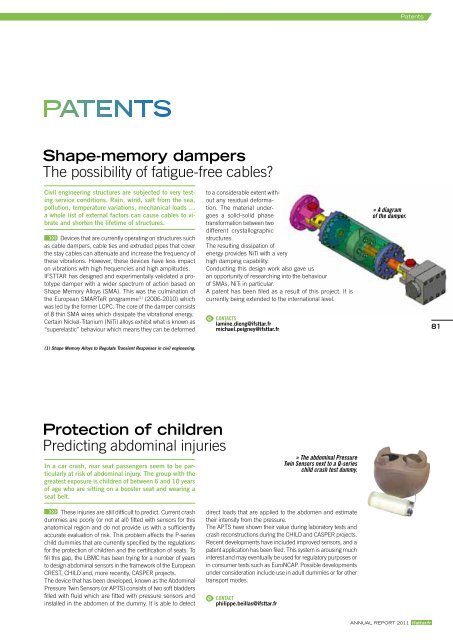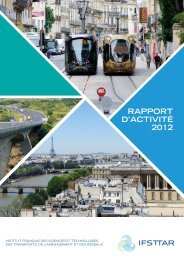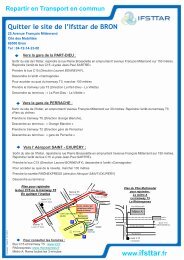french institute of science and technology for transport ... - Ifsttar
french institute of science and technology for transport ... - Ifsttar
french institute of science and technology for transport ... - Ifsttar
You also want an ePaper? Increase the reach of your titles
YUMPU automatically turns print PDFs into web optimized ePapers that Google loves.
Patents<br />
Shape-memory dampers<br />
The possibility <strong>of</strong> fatigue-free cables?<br />
Civil engineering structures are subjected to very testing<br />
service conditions. Rain, wind, salt from the sea,<br />
pollution, temperature variations, mechanical loads …<br />
a whole list <strong>of</strong> external factors can cause cables to vibrate<br />
<strong>and</strong> shorten the lifetime <strong>of</strong> structures.<br />
Devices that are currently operating on structures such<br />
as cable dampers, cable ties <strong>and</strong> extruded pipes that cover<br />
the stay cables can attenuate <strong>and</strong> increase the frequency <strong>of</strong><br />
these vibrations. However, these devices have less impact<br />
on vibrations with high frequencies <strong>and</strong> high amplitudes.<br />
IFSTTAR has designed <strong>and</strong> experimentally validated a prototype<br />
damper with a wider spectrum <strong>of</strong> action based on<br />
Shape Memory Alloys (SMA). This was the culmination <strong>of</strong><br />
the European SMARTeR programme (1) (2006-2010) which<br />
was led by the <strong>for</strong>mer LCPC. The core <strong>of</strong> the damper consists<br />
<strong>of</strong> 8 thin SMA wires which dissipate the vibrational energy.<br />
Certain Nickel-Titanium (NiTi) alloys exhibit what is known as<br />
“superelastic” behaviour which means they can be de<strong>for</strong>med<br />
to a considerable extent without<br />
any residual de<strong>for</strong>mation.<br />
The material undergoes<br />
a solid-solid phase<br />
trans<strong>for</strong>mation between two<br />
different crystallographic<br />
structures.<br />
The resulting dissipation <strong>of</strong><br />
energy provides NiTi with a very<br />
high damping capability.<br />
Conducting this design work also gave us<br />
an opportunity <strong>of</strong> researching into the behaviour<br />
<strong>of</strong> SMAs, NiTi in particular.<br />
A patent has been filed as a result <strong>of</strong> this project. It is<br />
currently being extended to the international level.<br />
@ CONTACTS<br />
lamine.dieng@ifsttar.fr<br />
michael.peigney@ifsttar.fr<br />
A diagram<br />
<strong>of</strong> the damper.<br />
81<br />
(1) Shape Memory Alloys to Regulate Transient Responses in civil engineering.<br />
Protection <strong>of</strong> children<br />
Predicting abdominal injuries<br />
In a car crash, rear seat passengers seem to be particularly<br />
at risk <strong>of</strong> abdominal injury. The group with the<br />
greatest exposure is children <strong>of</strong> between 6 <strong>and</strong> 10 years<br />
<strong>of</strong> age who are sitting on a booster seat <strong>and</strong> wearing a<br />
seat belt.<br />
The abdominal Pressure<br />
Twin Sensors next to a Q-series<br />
child crash test dummy.<br />
These injuries are still difficult to predict. Current crash<br />
dummies are poorly (or not at all) fitted with sensors <strong>for</strong> this<br />
anatomical region <strong>and</strong> do not provide us with a sufficiently<br />
accurate evaluation <strong>of</strong> risk. This problem affects the P-series<br />
child dummies that are currently specified by the regulations<br />
<strong>for</strong> the protection <strong>of</strong> children <strong>and</strong> the certification <strong>of</strong> seats. To<br />
fill this gap, the LBMC has been trying <strong>for</strong> a number <strong>of</strong> years<br />
to design abdominal sensors in the framework <strong>of</strong> the European<br />
CREST, CHILD <strong>and</strong>, more recently, CASPER projects.<br />
The device that has been developed, known as the Abdominal<br />
Pressure Twin Sensors (or APTS) consists <strong>of</strong> two s<strong>of</strong>t bladders<br />
filled with fluid which are fitted with pressure sensors <strong>and</strong><br />
installed in the abdomen <strong>of</strong> the dummy. It is able to detect<br />
direct loads that are applied to the abdomen <strong>and</strong> estimate<br />
their intensity from the pressure.<br />
The APTS have shown their value during laboratory tests <strong>and</strong><br />
crash reconstructions during the CHILD <strong>and</strong> CASPER projects.<br />
Recent developments have included improved sensors, <strong>and</strong> a<br />
patent application has been filed. This system is arousing much<br />
interest <strong>and</strong> may eventually be used <strong>for</strong> regulatory purposes or<br />
in consumer tests such as EuroNCAP. Possible developments<br />
under consideration include use in adult dummies or <strong>for</strong> other<br />
<strong>transport</strong> modes.<br />
@ CONTACT<br />
philippe.beillas@ifsttar.fr<br />
ANNUAL REPORT 2011 ifsttar.fr






![Trajectoire le magazine n°3 - Juillet 2012 [.pdf] - Ifsttar](https://img.yumpu.com/30038493/1/190x253/trajectoire-le-magazine-na3-juillet-2012-pdf-ifsttar.jpg?quality=85)

